
Retainer Cleaning Tablet vs. Retainer Cleaning Spray
Retainer Cleaning Tablet vs. Retainer Cleaning Spray
When braces are removed, teeth tend to move to their original position. However, retainers keep teeth in their new position.
If retainers are not cleaned regularly, they can accumulate bacteria, plaque, and odors. There are two prominent cleaning solutions for retainers that stand out: cleaning tablets and cleaning sprays. If you’d like a professional opinion then SmileSaver is one of the best options out there.
Let's discuss the advantages of each method and let’s see why sprays, particularly SmileSaver, are the better option of the two.
Speed and Convenience
One of the most significant advantages of Retainer Cleaning sprays vs. Retainer Cleaning tablets is the speed at which they work.
Cleaning tablets often require soaking for several minutes to hours, which can be inconvenient for those on the go.
In contrast, retainer cleaning sprays, such as SmileSaver, boast a rapid action formula that requires just 30 seconds to effectively clean your retainer.
This immediate cleaning not only saves time but also makes it easier to maintain retainer
hygiene throughout the day.

Ease of Use
Everybody loves easy solutions. When you’re using a tablet, you’ve to go through the hassle of finding a container, filling it with water, and waiting for the tablet to dissolve and clean the retainer. This process can be annoying and at times, patients would rather not clean than do all the effort, especially when they’re traveling.
Worry not, SmileSaver spray is here to simplify the process. A quick spray onto the retainer, a gentle scrub or rinse, and you're done. When it’s this easy to clean your retainers, you’re sure to clean them more frequently.
Portability
We understand that many patients lead busy lives or travel frequently. Here, portability becomes a crucial factor. Although retainer cleaning tablets are small, they require additional accessories like a container to fill with water. Not to mention the time it takes.
Sprays, like Smilesaver, however, are self-contained and can be carried in a bag or pocket for easy access anytime, anywhere.
Effectiveness in Cleaning
Both tablet and spray aim to kill bacteria and prevent plaque buildup. But, in addition to these advantages, sprays like SmileSaver also freshen retainers and lessen odor.
This multi-action capability ensures that retainers are not just clean but also pleasant to use. Furthermore, the targeted spray application ensures that all areas of the retainer are thoroughly cleaned.
Conclusion
Both retainer cleaning tablets and sprays offer effective solutions for maintaining oral appliance hygiene. However, as we have discussed, sprays, like Smilesaver, provide speed and convenience with their fast-acting formulas.
Not only that, but ease of use, effective cleaning capabilities, and portability make them a patient favorite. If you wish to maintain proper oral hygiene and ensure that retainers work optimally, SmileSaver is the clear winner.



Leave a comment
This site is protected by hCaptcha and the hCaptcha Privacy Policy and Terms of Service apply.